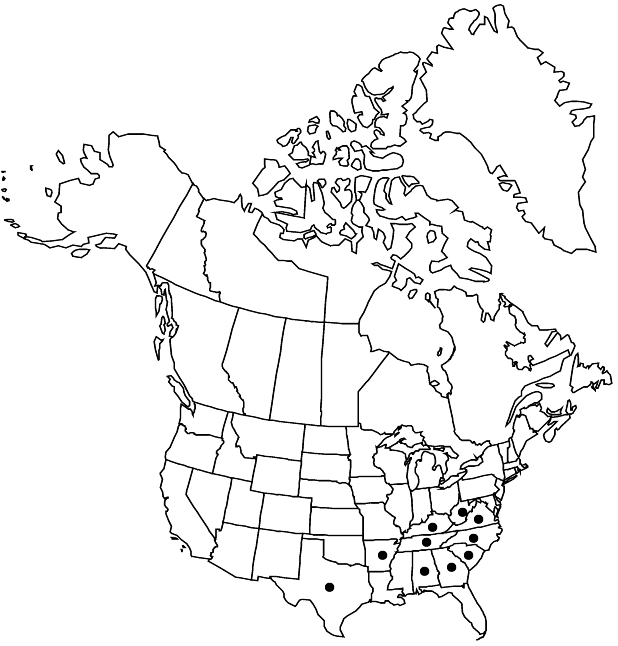Difference between revisions of "Lysimachia tonsa"
in H. G. A. Engler, Pflanzenr. 22[IV,237]: 277. 1905 ,.
FNA>Volume Importer |
imported>Volume Importer |
||
| (2 intermediate revisions by 2 users not shown) | |||
| Line 1: | Line 1: | ||
{{Treatment/ID | {{Treatment/ID | ||
|accepted_name=Lysimachia tonsa | |accepted_name=Lysimachia tonsa | ||
| − | |accepted_authority=(Alph. Wood) Alph. Wood ex R. Knuth | + | |accepted_authority=(Alph. Wood) Alph. Wood ex R. Knuth |
|publications={{Treatment/Publication | |publications={{Treatment/Publication | ||
|title=in H. G. A. Engler, Pflanzenr. | |title=in H. G. A. Engler, Pflanzenr. | ||
| Line 7: | Line 7: | ||
}} | }} | ||
|common_names=Appalachian or southern loosestrife | |common_names=Appalachian or southern loosestrife | ||
| + | |special_status={{Treatment/ID/Special_status | ||
| + | |code=E | ||
| + | |label=Endemic | ||
| + | }} | ||
|basionyms={{Treatment/ID/Basionym | |basionyms={{Treatment/ID/Basionym | ||
|name=Lysimachia ciliata var. tonsa | |name=Lysimachia ciliata var. tonsa | ||
| Line 49: | Line 53: | ||
-->{{#Taxon: | -->{{#Taxon: | ||
name=Lysimachia tonsa | name=Lysimachia tonsa | ||
| − | |authority=(Alph. Wood) Alph. Wood ex R. Knuth | + | |authority=(Alph. Wood) Alph. Wood ex R. Knuth |
|rank=species | |rank=species | ||
|parent rank=genus | |parent rank=genus | ||
| Line 62: | Line 66: | ||
|publication title=in H. G. A. Engler, Pflanzenr. | |publication title=in H. G. A. Engler, Pflanzenr. | ||
|publication year= | |publication year= | ||
| − | |special status= | + | |special status=Endemic |
| − | |source xml=https:// | + | |source xml=https://bitbucket.org/aafc-mbb/fna-data-curation/src/2e0870ddd59836b60bcf96646a41e87ea5a5943a/coarse_grained_fna_xml/V8/V8_635.xml |
|genus=Lysimachia | |genus=Lysimachia | ||
|species=Lysimachia tonsa | |species=Lysimachia tonsa | ||
Latest revision as of 22:45, 5 November 2020
Stems erect, simple or branched distally, 3–7 dm, stipitate-glandular or pubescent; rhizomes slender to thickened (sometimes absent); bulblets absent. Leaves opposite; petiole 0.5–4.5 cm, ciliate proximally near node, cilia 0.2–0.7(–1.2) mm; blade lanceolate to ovate, 3–9 × (0.8–)1–4.5 cm, base truncate, rounded, or cuneate, decurrent, margins entire or slightly sinuate, plane, sometimes obscurely ciliolate (rarely stipitate-glandular), apex acute to acuminate, surfaces not punctate, glabrous; venation pinnate-arcuate. Inflorescences axillary in distal leaves, solitary flowers or verticils. Pedicels 0.8–4 cm, stipitate-glandular at least distally. Flowers: sepals 5, calyx not streaked, 2.5–7.5 mm, glandular proximally or glabrous, lobes ovate to lanceolate, margins somewhat thickened; petals 5, corolla yellow, often with reddish base, not streaked, rotate, 6–12 mm, lobes with margins usually entire or sometimes erose distally, apex apiculate, stipitate-glandular adaxially; filaments distinct or nearly so, shorter than corolla; staminodes 0.6–1 mm. Capsules 3.5–5.8 mm, not punctate, glabrous. 2n = 34, 102.
Phenology: Flowering late summer.
Habitat: Moist hardwood forests, pine-oak woods, sandstone bluffs, rocky areas
Elevation: 0-600 m
Distribution

Ala., Ark., Ga., Ky., N.C., S.C., Tenn., Tex., Va., W.Va.
Discussion
Selected References
None.